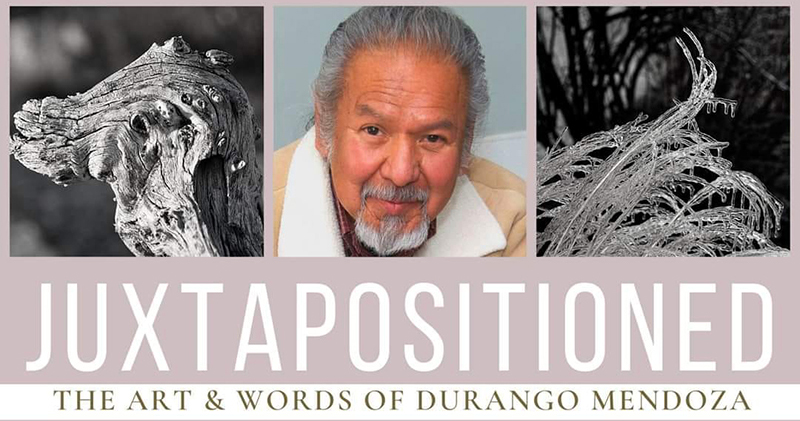I did not have the pleasure of knowing Durango Mendoza during the 26 years he lived in Urbana. Nor was I familiar with his vast body of work prior to learning that his widow, Jean, had received an Urbana Arts and Culture grant to curate and present what we now know as Juxtapositioned, a multi-location, multi-disciplinary retrospective. After experiencing Juxtapositioned: The art and words of Durango Mendoza, I very much wish I had known him, although in some sense, I now feel as though I do.
The choice of a multi-venue installation may have been due to breadth of Mendoza’s work. Or perhaps it was, as I like to believe, an opportunity to integrate Mendoza’s work and his message, back into the community he loved. Imagining young people, particularly young indigenous people, experiencing Mendoza’s work at the Urbana Free Library brings a smile to my face. As does the notion of City of Urbana staff and visitors pausing to consider Mendoza’s assemblages and the lessons they teach about identity, value, and inspiration.
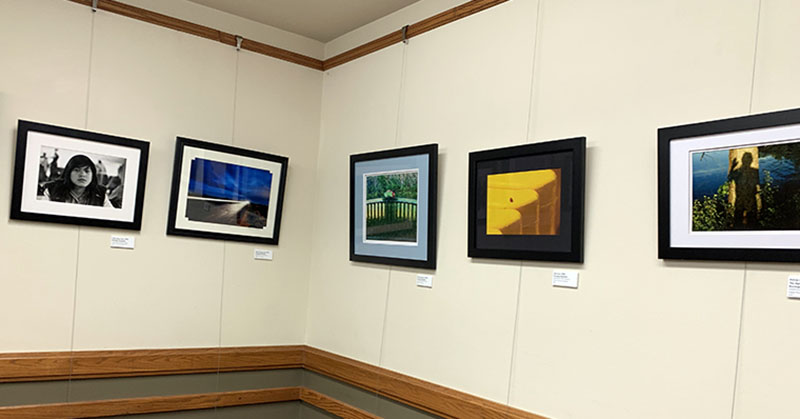
Photo by Debra Domal.
The three installations, which are differentiated in part by the size of the work displayed, take you on an Urbana art crawl of sorts. Depending on your path, you are likely to encounter any number of murals, sculptures, or graffiti art. These encounters may be a happy accident, but they are also an important component of the overall experience.
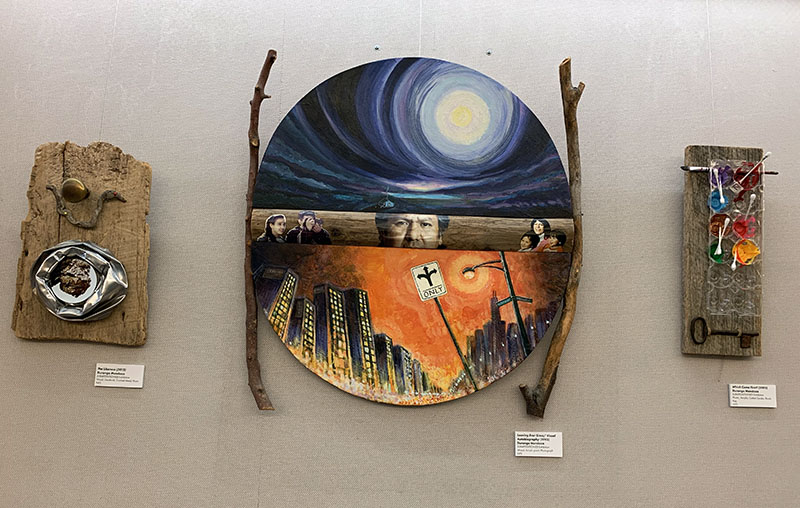
Photo by Debra Domal.
To experience a deeper understanding of the man and his work, certain biographical details, as well as certain aspects of Mendoza’s artistic philosophy should be understood. Throughout his life, Mendoza remained deeply thoughtful about his juxtapositioned identity. This process reveals itself throughout his work, as is true for many artists. However, Mendoza’s range of gifts, his ability to communicate as powerfully through assemblage as his did through word images, poetry, short fiction, and interviews, allowed him to leave behind both a map and a guidebook for those encountering his work.
These excerpts come from Mendoza’s 2015 with Sterling Cosper of the Muscogee Nation News.
“I am an enrolled member of the Muscogee (Creek) Nation of OK. My mother was full blood Creek, as were her parents. I grew into my teens in and around Dustin, OK. … I like to tell people that I am a barefoot boy from the country. [My Creek heritage] was filtered through the established culture of the Southern Baptist denomination that prevailed in the area.
True Muscogee heritage, when I was a child, was not referred to, although I knew the [ceremonial] grounds and that they had a strong … following. I also knew that many churchgoers attended stomp dances [at the ceremonial grounds] as well. It was only as an older adult that I did so myself.
My published short stories include bits of what I came to understand about this largely unclear aspect of my heritage, but which was revealed sporadically as cautionary tales, the veracity of which I could not determine. That fact did not keep me and my siblings from believing them.”
All of this … led me to look for meaning in whatever I saw and heard.
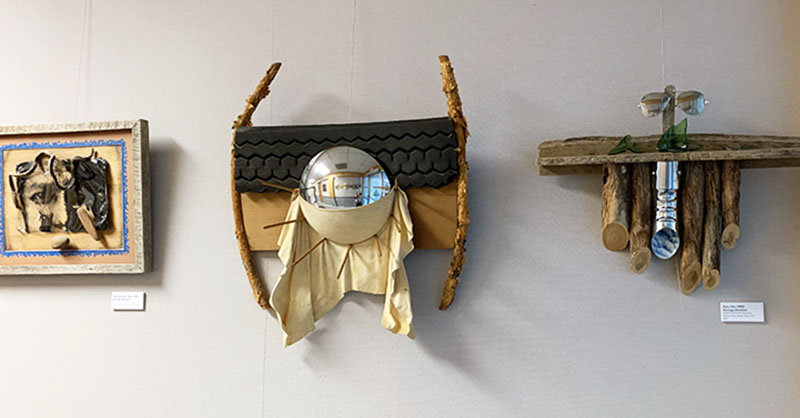
Photo by Debra Domal.
The art of assemblage was deeply personal for Mendoza, who viewed it as an exercise in meaning making and the construction of value. In that same interview with Sterling Cosper, he spoke of teaching these lessons to his children during their regular walks in the country.
“When my kids were little they asked me ‘Dad, why do you pick up all that stuff? I told them I only pick up things that speak to me.’ After that on walks they would find something and bring it me and say, ‘Daddy, does this speak to you? I tended to keep each one because I knew it probably spoke to them.”
These moments speak of Mendoza’s own meaning making experiences, as well as his deep desire to encourage others to upend traditional notions of value. “As I contemplate, say, the shiny and new juxtaposed with the damaged and rusted, ” he said. “or the weathered and natural, with the manufactured and discarded, some human emotions may be activated when the viewer is encouraged to alter their way of viewing.”
The installation at Art Coop is easily the largest and most like a traditional gallery experience. His larger assemblages inhabit the space well, allowing for space to walk among them and consider their connections.
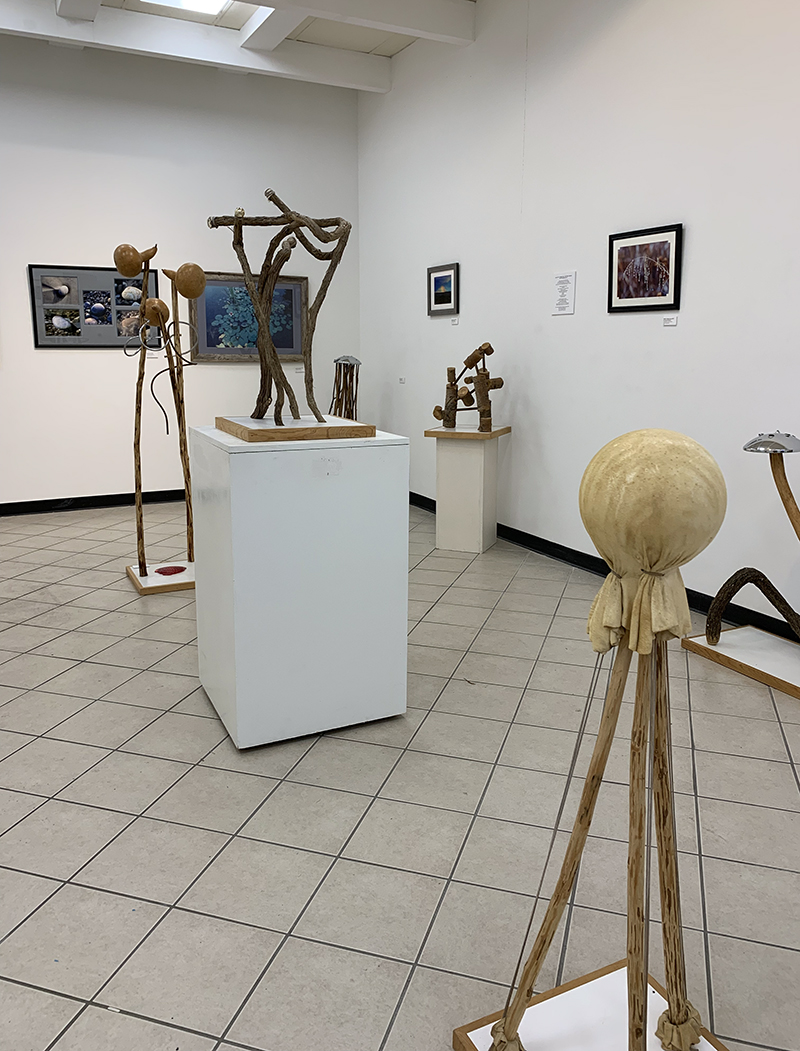
Photo by Debra Domal.
“[This is] the truth behind my work:
We are all assembled by nature and experiences.
As such, we become assemblers as well.
Much is possible when change is embraced.
Coincidence becomes choice.
Choice becomes purpose.
Purpose gives life to what is valued.”
—Durango Mendoza, circa 2000.
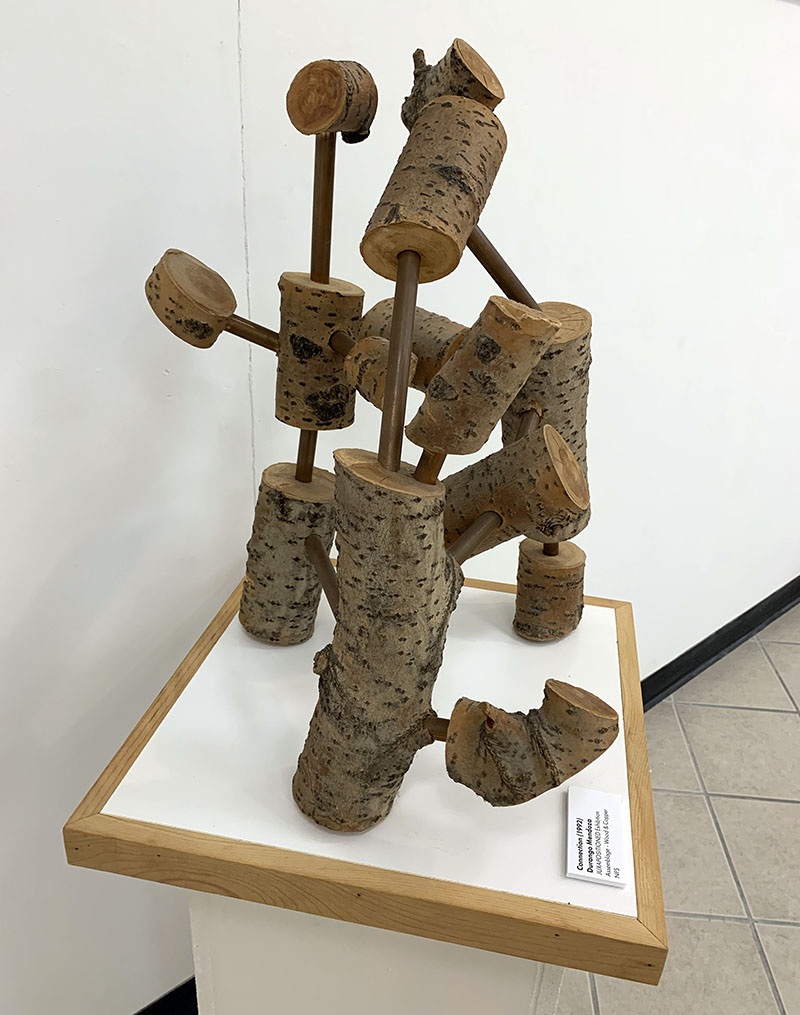
Durango Mendoz, Connection, Assemblage, wood and cooper., ©1992. Photo by Debra Domal.
The notion of being juxtapositioned is particularly apt for Mendoza’s work, as it speaks not only to the differences and similarities between the three installations, but also to the varied disciplines he worked in, and to his sense of self in his communities and in the universe.
“I was a between-the-culture kid
Life often seemed like a paradox,
So I paid a lot of attention to where things where, I examined things closely. Because I could not see that well.”“So I turned to what was constant and always there
Mother earth and father sky
The one to always hold you
And the other to lift you up.”
— Excerpted from Connections: Dichotomy, Paradox, and the Parenthetical.
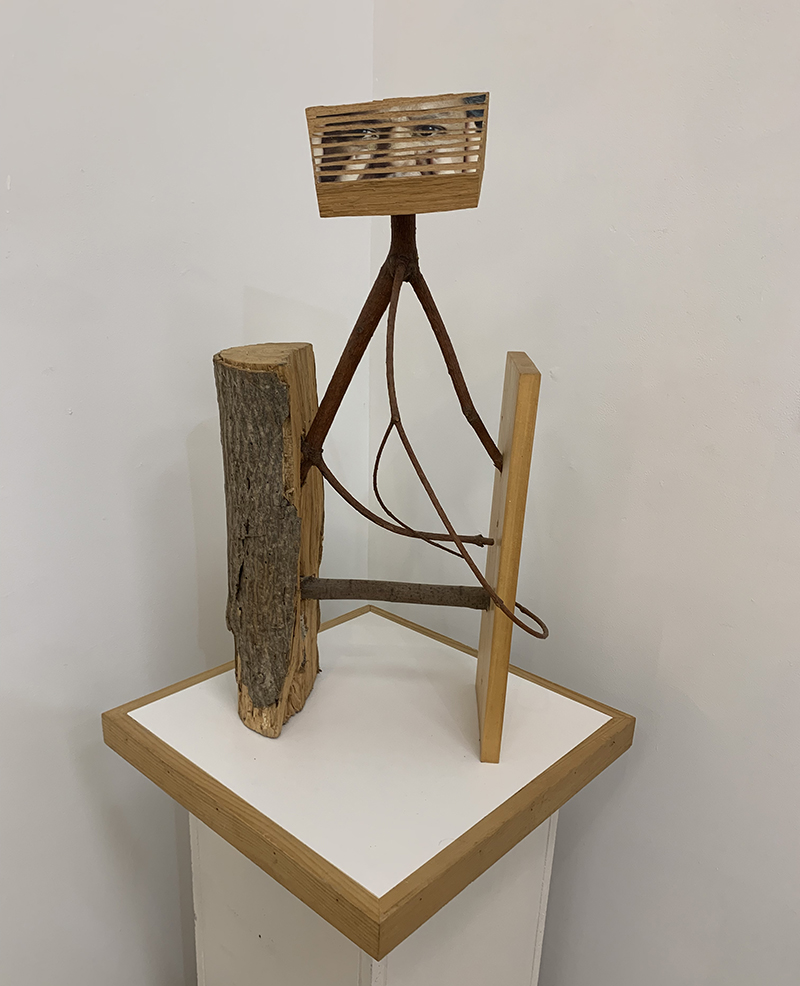
Durango Mendoza. Emergence: Self-Portrait, Assemblage, wood and photograph. ©1992. Photo by Debra Domal.
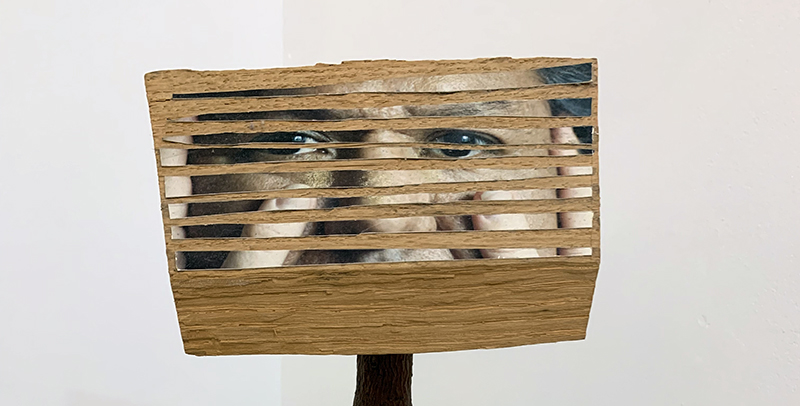
Durango Mendoza. Close-up of Emergence: Self-Portrait, Assemblage, wood and photograph. ©1992. Photo by Debra Domal.
Much of Mendoza’s work, visual and textual, investigates human experiences of the nature world. His connection to the elements is of an almost spiritual nature.
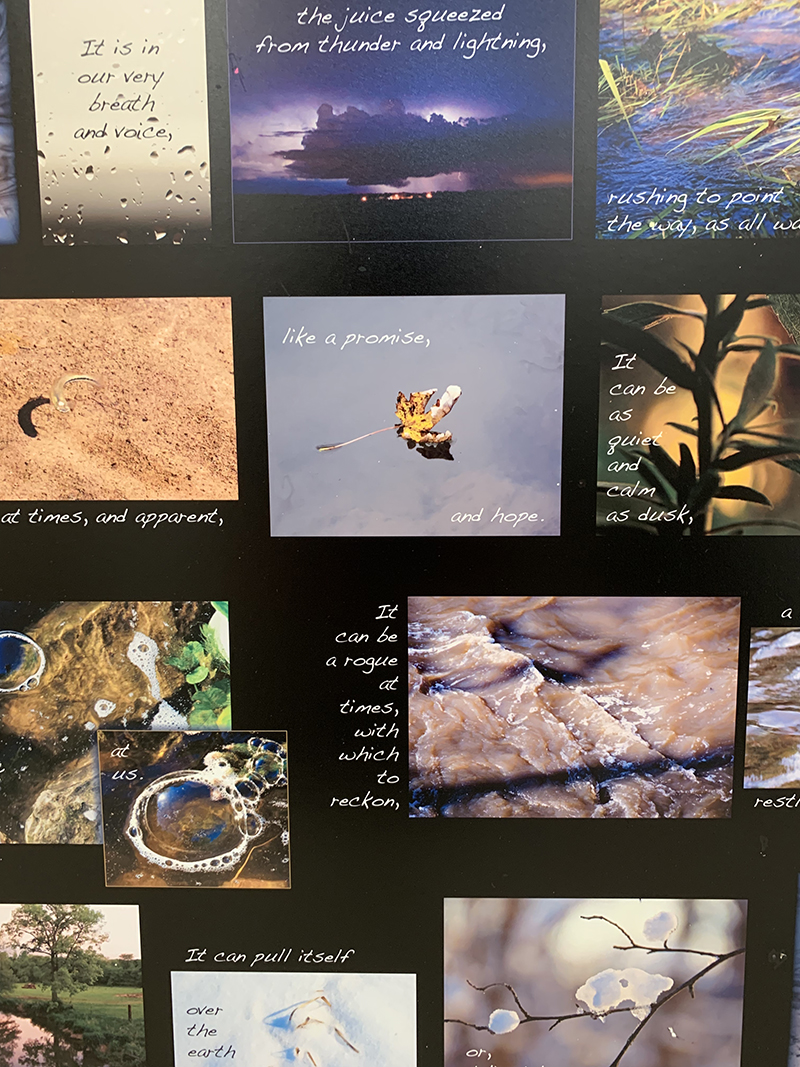
Durango Mendoza. Crop of Water is word images. Photo by Debra Domal.
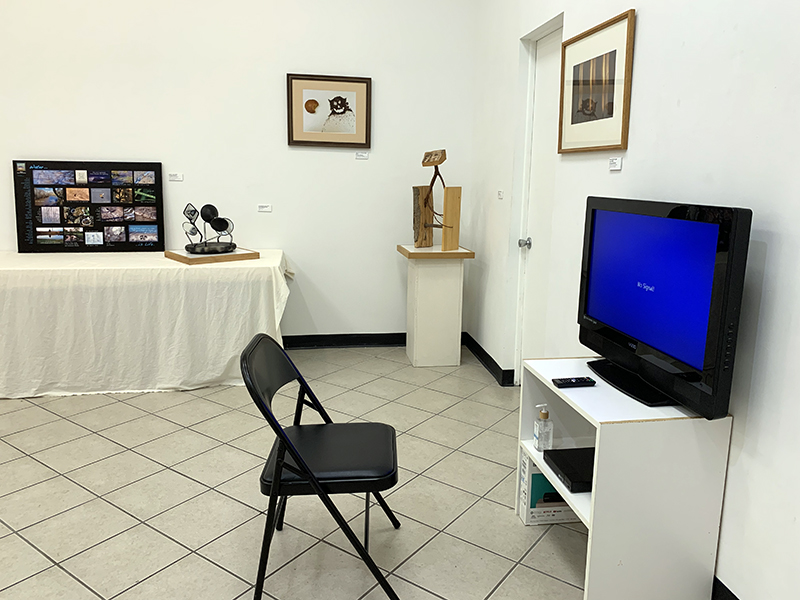
Photo by Debra Domal
The installation at Art Coop is perhaps the most interactive, offering guests a change to sit and experience a recording of Mendoza in his own words. They also show Mendoza’s oil paintings and his critical take on the role of Native American people and culture in modern art.
The journey through the three locations of Juxtapositioned is a journey worth taking, whether you take consecutively or individual experiences. It is also a journey, that if taken with a thoughtful mind and an open heart, may leave you transformed.
Though he may not have been a teacher by trade, Mendoza was clearly one in spirit. Therefore I feel it only right to conclude with his words, ones I’m sure he’d want you to carry with you across your own journey of juxtaposition. While they would be poignant at any point in time, these feel especially so in the current climate of divisiveness and fear.
“The goal is to encourage people, as different as they are, to see the potential and hope that is intrinsic in all things, and embrace diversity, acceptance, and change.”
As Durango Mendoza passed in October of 2020, during the height of the pandemic, this retrospective occurs the during the month of his belated memorial. The Mendoza family invites friends and fans of Durango’s work to join them at the celebration of life at 10:30 a.m. on Saturday, August 14th, at Wenner-Rikoff Chapel, 1900 S. Philo Road, Urbana.
Juxtapositioned: The art and words of Durango Mendoza
On display throughout the month of August at the following locations:
Mendoza’s smaller assemblages and word images will be on display at:
Urbana City Hall, first floor corridor
400 S. Vine St., Urbana
Mendoza’s photographs and word images will be on display at:
Urbana Free Library
210 E. Green St, Urbana
Get more information here
Mendoza’s large assemblages and word images will be on display at:
Art Coop
150 Lincoln Square
Hours: Monday through Friday, 10 a.m. to 6 p.m., Saturday, 10 a,.m. to 5 p.m.








